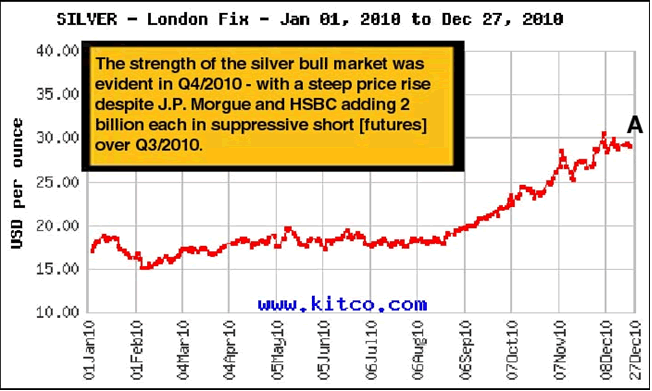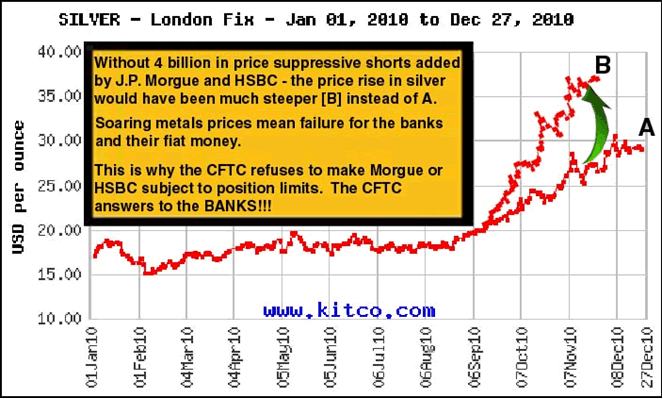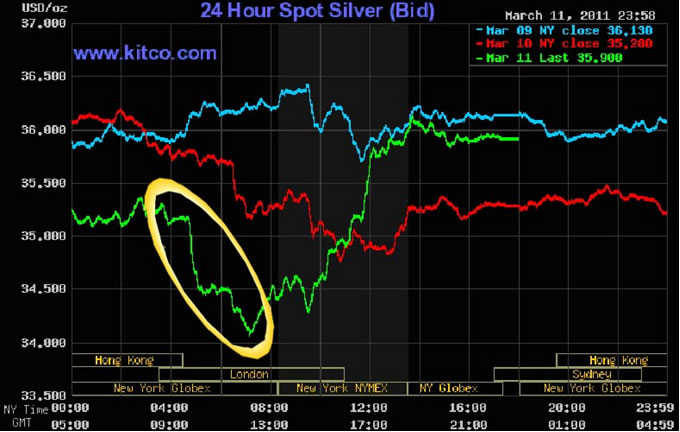Had JPMorgue and HSBS not sold an additional $4 Billion short in silver paper during Q4 of 2010, we wouldn't have been able to trade our fiat dollars for as many ounces of silver with our Q4 paychecks. One day soon, our perpetual silver discount courtesy our friends at JPMorgue and HSBS will end. Until that day comes, we'll continue to take advantage of the suppression and stock up!
The latest from Rob Kirby
This paper is written as a response to market observers who opine, “how can the price of precious metals be suppressed when their prices have empirically gone up 4 fold and more over the past 10 years?”
The following graph depicts the price performance of silver over the course of 2010, paying special attention to the change in silver derivatives positions at both J.P. Morgue and HSBC:

The U.S. Office of the Comptroller of the Currency [OCC] publishes quarterly data showing the change in aggregate derivatives data of reporting Commercial Banks:

When we juxtapose Q3/2010 precious metals aggregates against Q4/2010 – we can see that J.P. Morgue and HSBC cumulatively added roughly 4 billion in silver derivatives. We know these institutions are “short” because the Commitment of Traders Report [COTS] published weekly by the CFTC have perpetually shown the “Commercials” category to be short. J.P. Morgue and HSBC are “Commercials”.

What Could Have, Should Have But Wasn’t Allowed to Happen [thank you CFTC]:
While the price of silver did rise in Q4/2010 – in the absence of J.P. Morgue and HSBC piling on suppressive, paper, future short sales – the price rise would have undoubtedly been much steeper.
Conclusions: The price rise of silver in Q4/2010 would have been much steeper had J.P. Morgue and HSBC not “shellacked” the market with an additional, cumulative 4 billion in price-suppressive, paper short sales. Had these agents of the U.S. Federal Reserve not undertaken this market manipulation – the price of silver would have soared much higher, making the already weak U.S. Dollar look even more unattractive as a prudent vehicle for countries seeking diversification/safety of their reserve positions.
The CFTC is “owned” by the banks they are supposed to regulate. Instead of ensuring the sanctity of our capital markets, enforcing meaningful position limits, they aid-and-abet the banks in their price rigging [undoubtedly in the name of fiat preservation / National Security].
What is really occurring in precious metals-ville is that DEMAND for physical metal is now increasingly trumping the fraudulent, unlimited supply of paper metal [futures]. This is why “BEAT-DOWNS” in price – like the buck and half swoon depicted below [circled] on March 11, 2011 – no longer cause MASSIVE, LASTING breakdowns. A couple of years ago an engineered sell-off like the one depicted below would have decimated the silver market for months:

The real reason for the growing resilience in the metals markets is this: despite shills claiming that physical supply is no problem – institutional investors and national mints are having increasing difficulty sourcing physical metal.
In the past – smack downs in the price made investors wary and blunted demand. Today, investors are better informed and realize that smack downs in price when physical supplies are tight - are not only counter-intuitive, they’re a sign of desperation – and this brings buyers of physical metal “out of the woodwork”.
The game has fundamentally changed – but don’t tell the chartists – they’re still married to their Fibonacci retracements and buggy-whip, Bollinger bands.
With Central Banks continuing to increase the rate at which they create money out of thin air – we can logically expect this increased demand for physical precious metal to keep the price vectoring upward, to the right.
Got physical yet?
By Rob Kirby